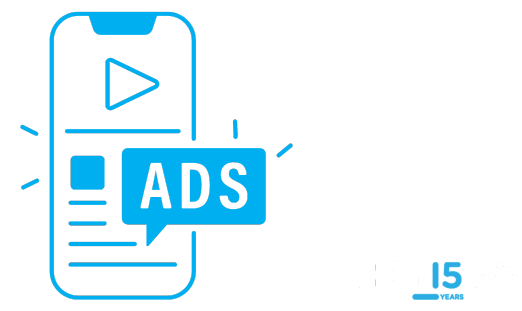
People nowadays talk about Facebook as if it’s the uncool dad of social media – and in some ways, it is. Indeed, Facebook has been around longer than its social counterparts like Twitter, Instagram, and LinkedIn. However, despite its age, you only need to look at the platform’s ad revenue to know that Facebook is anything but irrelevant. Read on to learn about Facebook ads for schools best practices.
As the second largest advertising platform in the world, Facebook Ads have a tremendous influence on what people buy, where people travel, and for our purposes, what schools people attend.
However, while Facebook Ads enable schools to reach large numbers of people, targeting your ideal prospects among the platform’s 2.45 billion monthly active users takes practice, strategy, and precision. Read on to learn how your school can leverage the power of Facebook Ads for student recruitment.
1. Best Facebook Ads for Schools: A Primer
If you’re just starting out with social media advertising and Facebook for schools, it may take a while before you get the hang of Facebook Ad Manager. But considering that 96% of marketers consider Facebook the most effective social media advertising platform, there’s no time like the present to start learning.
For starters, there are four layers to Facebook advertising, as demonstrated below. If you really want to maximize the platform’s power, consider not only creating a few ads, but a few sets of ads, under a single campaign.
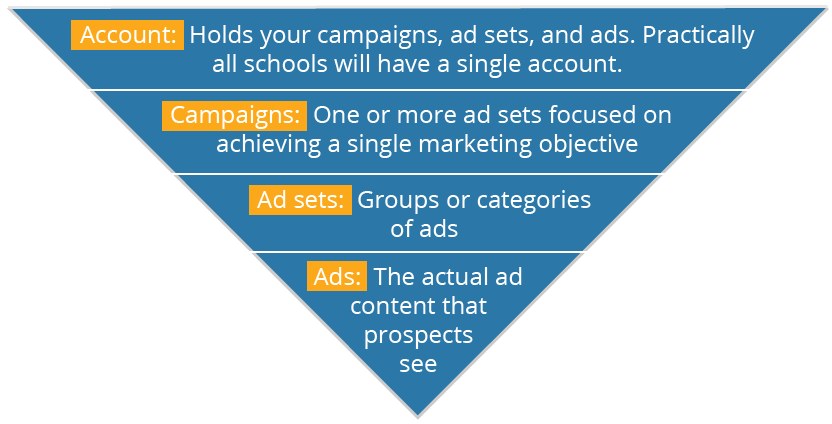
Source: Neil Patel
You can start by developing a campaign that focuses on driving a specific goal. Then, create ad sets that each highlight a different factor that drives prospects to fulfill that goal. Doing so creates opportunities for success in advertising for schools.
A business school, for instance, may want to create a Facebook campaign to boost enrollments in its online MBA program. They could create ad sets centered on the following selling points: career opportunities, innovative course content, and the ability to complete your degree online. The ads themselves could be in different formats and placed in various areas on Facebook.
2. Setting Your School’s Facebook Advertising Objectives
Whether you’re new to Facebook Ads or have created countless campaigns, it’s always good practice to set goals before you start your next campaign.
You can start by asking yourself the following questions:
- What am I promoting?
- Who am I targeting?
- What concerns do they have?
- What stage of the admissions process are they in?
- What is the goal of my campaign?
Later down the line, these ideas will help you target the appropriate audience, bid on the right metrics, and craft the perfect content. In the meantime, these goals will help your school set its marketing objectives when you start creating your ads.
Facebook advertisers must choose a marketing objective from the following list, which will dictate the format and pricing structure of your ads:
- Brand awareness
- Reach
- Traffic
- Engagement
- App installs
- Video views
- Lead generation
- Messages
- Conversions
- Catalogue Sales
- Store Visits
Of course, you’ll still have to put in the targeting and bidding legwork, but by choosing an accurate marketing objective, you’ll increase the chance of reaching your recruitment goals.
3. Define Your School’s Target Audience
From broad categories like country, to specific factors such as what sports game a user recently attended, Facebook’s targeting options are as varied as they are vast. It’s your job to find the right combination for reaching your ideal student audience.
If you’re wondering how to get around Facebook special ad categories, then understanding all of your options is key. Here’s a list of different categories you can explore and choose from when setting your audience parameters:
- Demographic Targeting: Target users by age, gender, etc.
- Location Targeting: Target users by region, city, and even postal code.
- Interest/Behavior Targeting: Target users by what they like and what they do online.
- Connection Targeting: Target users who have a connection to your brand
- Custom Audiences: Target users from your email list, or people who have performed certain actions on your website or social media channels
- Lookalike Audiences: Target users with similar characteristics to your custom audiences
If you want to introduce your school to new prospects, consider focusing on demographic, location, and interest-based targeting in order to expand your reach. Alternatively, if you want to convert leads who have shown interest in your school, make use of the connection targeting and custom audiences options in order to urge your existing prospects to connect further.
Your personas can also help you select the most effective targeting options.
Example: Schools looking to reach this persona could target ex-pats in their 20s and 30s living in Ontario.
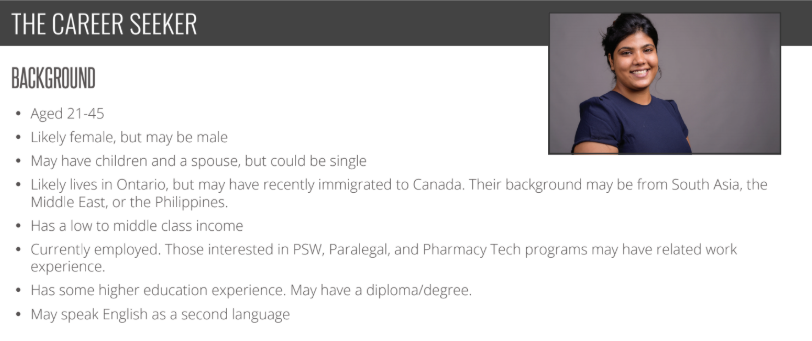
As you define your prospective student audience, look for the sweet spot between an audience that’s overly broad, and one that is too narrow. Facebook even helps you do that for you through barometer targeting. As you add targeting options, the barometer will show you whether your audience is too broad, too narrow, or right on target. It will also give you an approximation of how many people you will reach.
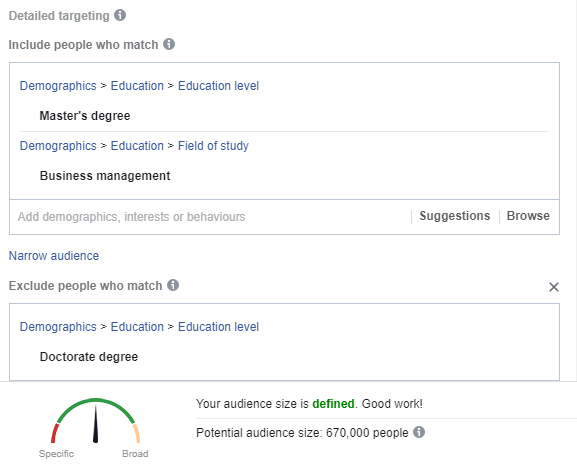
The key for the best Facebook Ads for schools is to select specific targeting options that accurately pinpoint high quality leads and omit outliers – while still being general enough to reach a large audience.
4. Set Your School’s Facebook Ads Budget
Once you’ve got your paid advertising plan set, you’ll have to put money into your ads in order to bring them to life.
Advertisers can choose which action they want to bid on. They could pay each time someone clicks on their ad, for instance, or for every 1,000 impressions their ad generates.
However, the relevance of your ad also plays a part in how much you spend on it. Facebook Ads are given a Relevance Score, which is Facebook’s way of weighing positive sentiment towards your ad against negative reactions. The higher your Relevance Score is, the lower your CPC and the better click-through rates (CTR) you can expect.
Once you’ve got your ads created, your budget set, as well as your audience targeted, you can use Facebook Ads Manager to monitor your campaign and adjust it accordingly.
Optimizing Your Facebook Ad bids
As with any digital marketing initiative, you want to make sure you’re getting adequate bang for your buck. Without paying careful attention to your Facebook Ad bids, you risk paying too much for your ad results. Alternatively, if your bids are too low, no one will see your ads in the first place.
Optimizing your ad bids all starts with strategically setting your budget. You can choose whether you want to bid a certain amount per day, or set a lifetime budget, which is the total amount you’ll be spending on your ad.
You can also choose whether you want to run your ad set continuously starting on the day you create it, or set a start and end date for your campaign. Schools also have the option of ‘dayparting,’ which means you can set the specific times and days you want your ad to run over a certain period of time.
After you’ve ran a few ads, and know which times and days generate the most traffic, you should specify your duration and budget in order to allocate your ad spend most effectively.
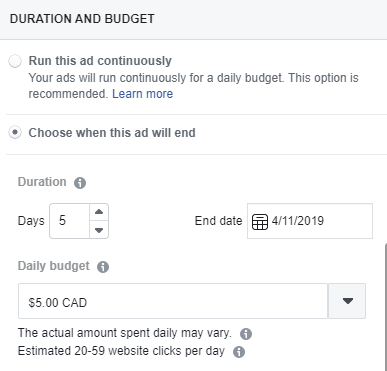
The next step in the budgeting process is choosing which factor – including link clicks, impressions, and daily unique reach – you want to optimize your ad for. Choose carefully, as the one you pick will influence who sees your ad, as well as what metric you bid on.
For example, if you optimize your ad for link clicks to your website, you will pay your CPC bid every time someone clicks your ad. Optimizing for impressions, on the other hand, means that you will pay each time your ad generates a thousand impressions. Keep in mind that the optimization factor you choose will influence your daily reach, as it’s a whole lot easier to generate impressions than it is to find people who are willing to click your link.
After you’ve set up all your budget parameters, then comes the meat and potatoes of Facebook advertising: setting your bids.
Schools can choose between automatic bidding, where Facebook sets a bid for you, and manual bidding, where you determine the cost yourself.
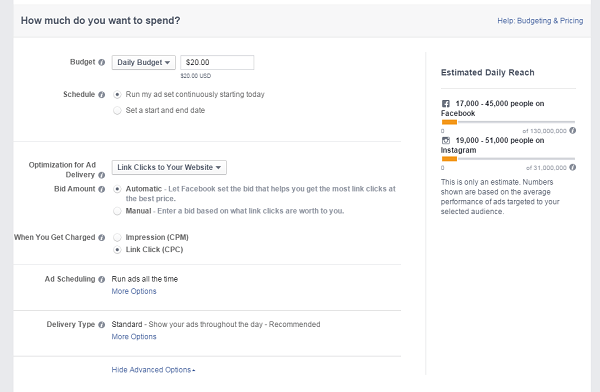
If you’re new to Facebook advertising, you will likely want to use automatic bidding to ease into the process, as it’s pretty self-explanatory. But once you’ve got a good idea of what your ads are worth and want to step up your efforts, you may want to try manual bidding.
In addition to capitalizing on your ad spend, manual bidding gives you the additional option of bidding on conversions (if you optimize your ad for ‘web conversions’).
If you go the manual bidding route, Facebook will give you a range that you can bid within. Advertisers are generally best off bidding in the middle of that range – but keep in mind that you’ll usually pay lower than your bid.
To amplify your reach, you could place a bid in the upper range. Alternatively, you could bid lower if the click is worth less than what Facebook suggests. However, keep in mind that if your bid is too low your ad won’t be seen at all.
It can take practice to know how much to bid on each ad set, so be sure to check the bid range regularly throughout the campaign. If more people bid, the range can increase, and you never want your bid to fall below that threshold.
5. Create Winning Higher Ed Ad Content
Once you’ve got all the nitty gritty details out of the way, you can now embark on the creative part of your school’s Facebook strategy: crafting your perfect ad content.
Types of Facebook Ads for Schools
Essentially, there are five components to a standard Facebook Ad: body text, photos/video, link, heading, and CTA.
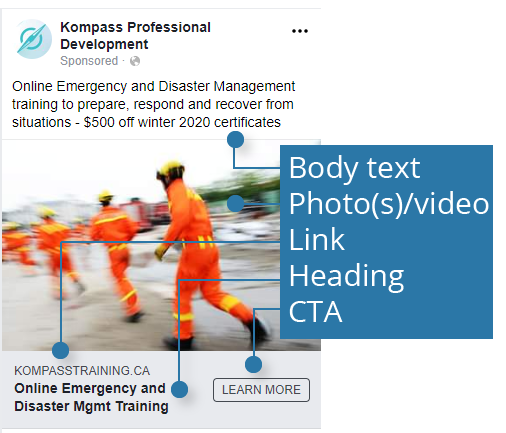
The exact components of your ad will depend on what format and placement you choose – but there is one element common across all ad types: a CTA. You can choose from a number of different preset buttons based on your recruitment goals.
If you want to drive bookings or applications, Book Now would be a suitable CTA. If you want prospects to submit an inquiry, you may want to use the Contact Us CTA. The Learn More CTA is a great general CTA to use if you want prospects to see why your school is a great fit.
The type of ad you choose may also influence the kind of CTA you use. Many advertisers opt for standard formats such as single image or video ads, but you can also add more visuals by creating carousel ads (where prospects can click through different photos) or collection ads which display a number of different images. Stories ads are becoming increasingly common on Facebook as well.
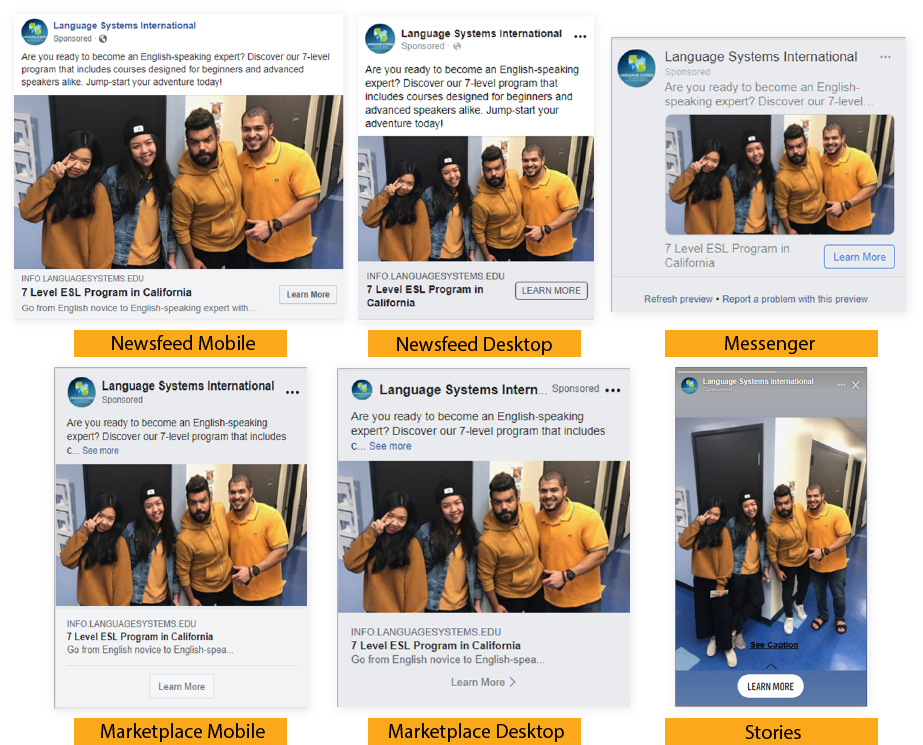
Since Instagram ads fall under Facebook’s Ad Manager, you also have a number of different ad formats and placements you can use on the photo-sharing platform. Check out this blog to learn more about Instagram Ads for schools.
Facebook Ad Content Best Practices
Most users scrolling through Facebook will barely glance at the posts they come across, so you want to make sure that your ad stands out on your prospects’ news feeds.
You also want to make sure your ads are as clear as possible. Since Facebook offers endless content, your prospects will move on to the next post if they find your ad any bit confusing or jarring.
For maximum results, you should also make sure that every component of your ad is cohesive. In other words, your visuals, body text, title, and CTA should all work together to drive prospects to click your ad.
Example: This ad for Kompass Professional Development’s Online Emergency and Disaster Management course features a bright, dynamic photo that would likely catch the eye of someone looking for an action-packed job. The text is brief and includes a compelling offer.
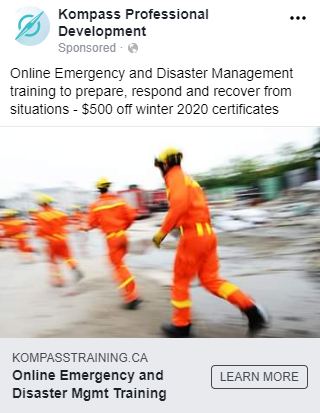
Oftentimes, the body text is where advertisers slip up, as it’s tempting to want to include as much information as possible – but if your text is too long, Facebook will break it off with a ‘Read More’ button, which is not ideal when it comes to your ad’s scannability.
Landing Pages
Sometimes, advertisers devote all their energy to creating the perfect ad, but don’t pay sufficient attention to what happens after the lead clicks on it.
This isn’t a big deal if you’ve created lead ads, as there aren’t any landing pages involved. When a prospect clicks on this type of ad, a Facebook form – aka a ‘contact form’ or ‘instant form’ – appears.

Source: Facebook
The great thing about this type of ad is that it’s native to the platform, and is autofilled with your prospects’ contact information, thereby increasing the likelihood that they’ll fill in the form. However, since these ads only allow you to use a preset form template, you won’t be able to include extra information about your school.
If you want to simply get contact information and build your email list, lead ads will expedite that process. But if you want to showcase your school to prospects, or invite them to take specific actions, you’ll need a landing page devoted to that purpose.
Example: This Lakefield College School landing page highlights the school’s stunning campus, showcases some alumni testimonials, and offers just enough information to entice others to attend – without overloading them with content. The landing page also includes a form that is foregrounded at the top of the page. If prospects automatically scroll to the bottom, there’s an arrow directing you back up to the form, so prospects won’t miss the opportunity to connect with the school.

Make sure that your landing page also fulfills your prospects expectations when they click on your Facebook ad. If your ad invites prospects to explore your school’s MBA program, for example, make sure your landing page does just that. Don’t offer prospects a general business landing school page when you know that it’s your MBA degree they really want to learn about.
Additionally, you may also want to consider creating a number of different landing pages in order to test them and see which drives the most form submissions.
6. Monitoring and Optimizing Your Facebook Ads
The world of Facebook advertising is highly complex, and it’s difficult to achieve the results you expect. Even if you follow all the best practices, and optimize each aspect of your ad, you may experience some unexpected – and unavoidable – challenges.
Thus, no matter how well executed your initial strategy is, you’ll want to pay close attention to your ads and make any necessary adjustments to maximize your recruitment results through Facebook Ads for schools.
Luckily, Facebook Ads Manager offers in-depth insight into your ad performance which can help your school do that.

It can often be overwhelming sifting through the buckets of data available on the platform, but here are some metrics you should keep track of on a weekly basis:
- Impressions
- Link Clicks
- CPC
- CTR
- Leads
Since your CPC and CTR are directly related to how much your school is paying, and how frequently you’re paying, these factors will likely be the ones that determine whether you rotate an ad, keep it active, or change the amount of money you have allocated to it.
To give your school Facebook Ads an extra special boost, you may want to also consider remarketing or lookalike campaigns after your ads have been running for a while. These ads involve highly accurate targeting, and therefore tend to have a high conversion rate.
Example: Lookalike campaigns can help schools break into new markets, as you can target those with similar attributes to your target audience, but in different locations. In this case, a school set up a Lookalike campaign to reach prospects in South Korea.

Throughout the optimization process, make sure to take note of what makes an ad perform well and what hinders its effectiveness so you can keep improving your Facebook Ads over time.
Nothing in digital marketing comes easy, but with practice, experimentation, and careful monitoring, your school can learn how to master the art of Facebook advertising. This skillset will definitely pay off in the long run as you’ll have the ability to reach millions of prospects on the world’s biggest social media channel.


